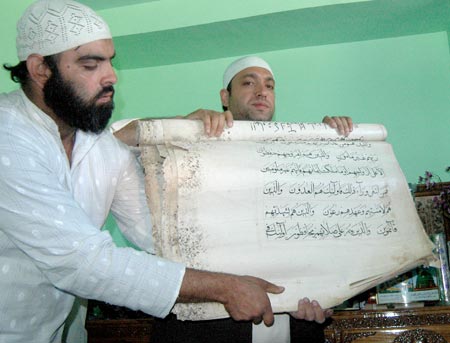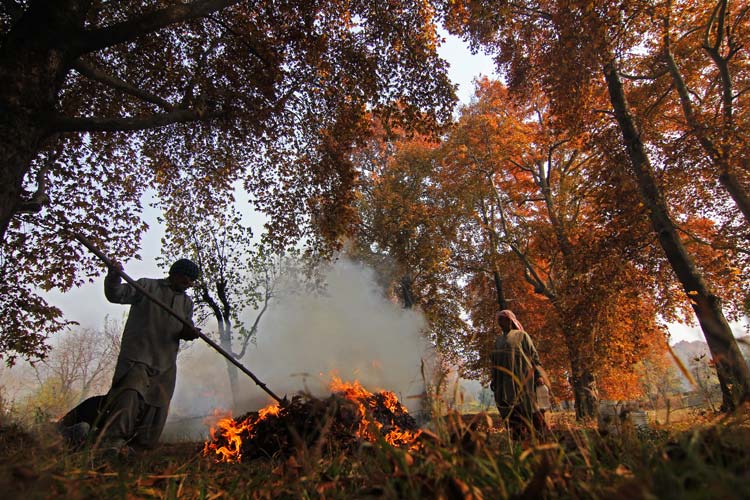Kashmir, the Valley of saints, is host to a large number of holy relics most of which are not displayed before the general public. Syed Asma details some of them.

It is only after the Sajjada Nisheen displayed the holy relics of Sheikh Abdul Qadir Jeelani’ (RA) shrine before the media that common folk came to know about their presence. On the Urs of Sheikh Abdul Qadir Jeelani, only his moye mubarak is displayed.
But recently, many of the other relics that were housed in the destroyed shrine were also displayed before the media to assure the masses about their safety and safekeeping.
The relics displayed include a Nama-e- shareef and a copy of Quran. The Nama e Shareef with Quranic verses written on it is believed to be an amulet (taaweez) written by Hazrat Ali (RA) on the skin of a musk deer (Roos Kaet) for Hazrat Hasan (RA).
The copy of Quran in the shrine is believed to have been written by the first caliph of Islam, Abu Bakr Siddique (RA). This belief is however seen with skepticism by historians and the researchers in Kashmir who maintain that no such thing has ever been attributed to this revered companion of the Prophet (SAW) elsewhere.
“If the claims are true, it would be the only one of its kind and would not only have a high religious relevance but a unique historical importance as well,” says a historian.
Besides, there are other relics which were not displayed before the media include the turban (Dastaar/Kullah Sharief), Wooden Staff (Asa Sharief), Robe (Jama Mubarak) of Hazrat Sakhi Shah Fazil Qadri (RA), the 18th descendent of Sheikh Abdul Qadir Jeelani of Baghdad, who had come to Kashmir from Thatha Sind, Pakistan along with his brother Abul Hasan and is buried at Khanyar inside the shrine along with some of his disciples, Khwaja Qazi Abdul Qadir Khan Chewu known as Qazi Khan, Buzrug Shah and Ghulam din Azad along with his wife.
It was, however, not Hazrat Fazil Qadri (RA) who got the moye sharief of his great grandfather but a local merchant Buzurg Shah, who had good contacts in Bagdad and managed to get it from there, Tariq says.
Dastgeer Sahib’s shrine was built around 1182 Hijri, approximately 1781 AD, as its foundation stone in Persian reads “Saal-i tareekh ien bina Azad guft shud khanqahi Jeelani 1182 hijri”.
The basic structure of the shrine was built up by one of the disciples of Sakhi Shah Fazil, Qazi khan, a local. It was later renovated by Buzurg Shah but it is said that the intricacies like Khatam band and Papier mache work of the shrine were got done by Khwaja Sonallah Shawl, a very famous businessman of Kashmir during the reign of Ranbir Singh, says Zareef Ahmed Zareef.
Dastageer Sahib’s shrine was perhaps the only shrine in the valley which had not been rebuilt since its first built.
The only other shrine whose old structure is intact, is the 400 year old shrine of Hazrat Baha-ud-Din Naqashbandi (RA), locally known as Naqasband Sahib’s shrine. The shrine is the perfect example of Daji diwaari style of architecture. Hazrat Khwaja Sheikh Mohi ud din Naqashbandi (RA) another saint of the Naqshbandi order is buried here. The belongings of the saint though present in the shrine are rarely displayed. The graveyard adjoining the shrine has a contemporary political relevance as it is the resting place of all the martyrs of July 13, 1931.
It is this place where the Moy-i-Muqadas of Hazrat Muhammed (SAW) was placed before shifting it to Hazratbal. The details of its landing in Kashmir are not clear but it is said that Aurangzab Alamgir, a Mughal ruler had got it here during the rule of Mughal Governor Saadiq Khan. The Moy-i-Muqadas was later shifted to Saadiqabad, later renamed as Hazratbal, in 1111 Hijri, approximately 1699 CE. In Saadiqabad, the Moy-i-Muqaddas was housed in a resort ,“Ishrat Mahal” constructed in the times of Emperor Shahjahan who impressed with its serene environs had suggested it to be a religious place rather than a resort, says Zareef Ahmed Zareef.
It was later in 1968 that Sheikh Mohammed Abdullah decided to reconstruct the Dargah on the pattern of Masjid-i-Nabwi. It took 11 years to complete the reconstruction which was done exclusively with public donations.
Hazratbal is not the only place where the grand holy relic of Moy-i-Muqadas exists. It is also present in a shrines aKalashpora and Jenab Sahib Soura.
Jenab Sahib Soura shrine is not attributed to any particular saint but has been a place of meditation and preaching for many saints. The relics adorning the precincts are Jama Mubarak of















